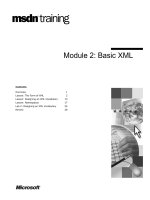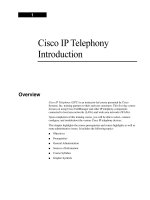Tài liệu What Is an Array? docx
Bạn đang xem bản rút gọn của tài liệu. Xem và tải ngay bản đầy đủ của tài liệu tại đây (26.6 KB, 6 trang )
What Is an Array?
An array is an unordered sequence of elements. All the elements in an array have the
same type (unlike the fields in a struct or class, which can have different types). The
elements of an array live in a contiguous block of memory and are accessed by using an
integer index (unlike fields in a struct or class, which are accessed by name).
Declaring Array Variables
You declare an array variable by specifying the name of the element type, followed by a
pair of square brackets, followed by the variable name. The square brackets signify that
the variable is an array. For example, to declare an array of int variables called pins, you
would write:
int[] pins; // Personal Identification Numbers
Microsoft Visual Basic programmers should note that you use square brackets and not
parentheses. C and C++ programmers should note that the size of the array is not part of
the declaration. Java programmers should note that you must place the square brackets
before the variable name.
NOTE
You are not restricted to primitive types as array elements. You can also create arrays of
structs, enums, and classes. For example, to create an array of Time structs you would
use Time[] times;
TIP
It is useful to give array variable plural names, such as places (where each element is a
Place), people (where each element is a Person), or times (where each element is a Time).
Creating Array Instances
Arrays are reference types, regardless of the type of their elements. This means that an
array variable refers to an array instance on the heap (just as a class variable refers to an
object on the heap) and does not hold its array elements directly on the stack (as a struct
does). (To review values and references and the differences between the stack and the
heap, see Chapter 8, “Understanding Values and References.”) Remember that when you
declare a class variable, memory is not allocated for the object until you create the
instance by using new. Arrays follow the same rules—when you declare an array
variable, you do not declare its size. You specify the size of an array only when you
actually create the array instance.
To create an array instance, you use the new keyword followed by the name of the
element type, followed by the size of the array you're creating between square brackets.
Creating an array also initializes its elements by using the now familiar default values (0,
null, or false depending on the type). For example, to create and initialize a new array of
four integers for the pins variable declared earlier, you write this:
pins = new int[4];
The following graphic illustrates the effects of this statement:
The size of an array instance does not have to be a constant; it can be calculated at run
time, as shown in this example:
int size = int.Parse(Console.ReadLine());
int[] pins = new int[size];
You're allowed to create an array whose size is 0. This might sound bizarre, but it's useful
in situations where the size of the array is determined dynamically and could be 0. An
array of size 0 is not a null array.
It's also possible to create multidimensional arrays. For example, to create a two-
dimensional array, you create an array that requires two integer indexes. Further
discussion of multi-dimensional arrays is beyond the scope of this book, but here's an
example:
int[,] table = new int[4,6];
Initializing Array Variables
When you create an array instance, all the elements of the array instance are initialized to
a default value depending on their type. You can modify this behavior and initialize the
elements of an array to specific values if you prefer. You achieve this by providing a
comma-separated list of values between a pair of curly brackets. For example, to
initialize pins to an array of 4 int variables whose values are 9, 3, 7, and 2, you would
write this:
int[] pins = new int[4]{ 9, 3, 7, 2 };
The values between the curly brackets do not have to be constants. They can be values
calculated at run time, as shown in this example:
Random r = new Random();
int[] pins = new int[4]{ r.Next() % 10, r.Next() % 10,
r.Next() % 10, r.Next() % 10 };
NOTE
The System.Random class is a pseudo-random number generator. The Next method
returns a nonnegative random number.
The number of values between the curly brackets must exactly match the size of the array
instance being created:
int[] pins = new int[3]{ 9, 3, 7, 2 }; // compile time error
int[] pins = new int[4]{ 9, 3, 7 }; // compile time error
int[] pins = new int[4]{ 9, 3, 7, 2 }; // okay
When you're initializing an array variable, you can actually omit the new expression and
the size of the array. The compiler calculates the size from the number of initializers, and
generate codes to create the array. For example:
int[] pins = { 9, 3, 7, 2 };
If you create an array of structs, you can initialize each struct in the array by calling the
struct constructor, as shown in this example:
Time[] schedule = { new Time(12,30), new Time(5,30) };
Accessing Individual Array Elements
To access an individual array element, you must provide an index indicating which
element you require. For example, you can read the contents of element 2 of the pins
array into an int variable by using the following code:
int myPin;
myPin = pins[2];
Similarly, you can change the contents of an array by assigning a value to an indexed
element:
myPin = 1645;
pins[2] = myPin;
Array indexes are zero-based. The initial element of an array lives at index 0 and not
index 1. An index value of 1 accesses the second element.
All array element access is bounds-checked. If you use an integer index that is less than 0
or greater than or equal to the length of the array, the compiler throws an
IndexOutOfRangeException, as in this example:
try
{
int[] pins = { 9, 3, 7, 2 };
Console.WriteLine(pins[4]); // error, the 4th element is at index 3
}
catch (IndexOutOfRangeException ex)
{
...
}
Iterating Through an Array
Arrays have a number of useful built-in properties and methods (all arrays inherit
methods and properties from the System.Array class in the Microsoft .NET Framework).
You can use the Length property to find out how many elements an array contains. You
can make use of the Length property to iterate through all the elements of an array by
using a for statement. The following sample code writes the array element values of the
pins array to the console:
int[] pins = { 9, 3, 7, 2 };
for (int index = 0; index != pins.Length; index++)
{
int pin = pins[index];
Console.WriteLine(pin);
}
NOTE
Length is a property and not a method, which is why there are no brackets when you call
it. You will learn about properties in Chapter 14, “Implementing Properties to Access
Attributes.”
It is common for new programmers to forget that arrays start at element zero, and that the
last element is numbered Length – 1. C# provides the foreach statement to iterate through
the elements of an array without worrying about these issues. For example, here's the
previous for statement rewritten as an equivalent foreach statement:
int[] pins = { 9, 3, 7, 2 };
foreach (int pin in pins)
{
Console.WriteLine(pin);
}
The foreach statement declares an iteration variable (in the example, int pin) that
automatically acquires the value of each element in the array. This construct is much
more declarative; it expresses the intention of the code much more directly and all of the
for loop scaffolding drops away. The foreach statement is the preferred way to iterate
through an array. However, in a few cases, you'll find you have to revert to a for
statement:
•
A foreach statement always iterates through the whole array. If you want only to
iterate through a known portion of an array (for example, the first half), or to
bypass certain elements (for example, every third element), it's easier to use a for
statement.
•
A foreach statement always iterates from index zero through index Length – 1. If
you want to iterate backwards, it's easier to use a for statement.
•
If the body of the loop needs to know the index of the element rather than just the
value of the element, you'll have to use a for statement.
•
If you need to modify the elements of the array, you'll have to use a for statement.
This is because the iteration variable of the foreach statement is a read-only copy
of each element of the array.
Copying Arrays
Arrays are reference types. An array variable contains a reference to an array instance.
This means that when you copy an array variable, you end up with two references to the
same array instance, for example:
int[] pins = { 9, 3, 7, 2 };
int[] alias = pins; // alias and pins refer to the same array instance
In this example,if you modify the value at pins[1], the change will also be visible by
reading alias[1].
If you want to make a copy of the array instance (the data on the heap) that an array
variable refers to, you have to do two things. First, you need to create a new array
instance of the same type and the same length as the array you are copying, as in this
example:
int[] pins = { 9, 3, 7, 2 };
int[] copy = new int[4];
This works, but if you later modify the code to change the length of the original array,
you must remember to also change the size of the copy. It's better to determine the length
of an array by using its Length property, as shown in this example:
int[] pins = { 9, 3, 7, 2 };
int[] copy = new int[pins.Length];
The values inside copy are now all initialized to their default value of 0.









